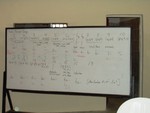u̱t-Maꞌin noun research
The U̱t-Maꞌin language is characterized by a complex noun classification system and a robust agreement system that permeates the language. While an understanding of the noun classes is essential to an understanding of the language as a whole, discussion includes the division of nouns into fourteen distinct classes, marked by prefixes on the nouns themselves and by agreement elements on other clause constituents.
Five of fourteen noun class prefixes are involved in nominalization of the verb; a nominalized verb, along with a goal complement or an object, can be incorporated into the nominalized phrase in the same way that a noun modifier is marked within a NP. These nominalized verb phrases are extensively used in auxiliary constructions that cover a diverse range of tense, aspect, and mode designations; the syntactic transitivity of the clause determines the morphosyntax used. Intransitive auxiliary constructions use the full range of nominalizing noun class marking; in contrast, transitive auxiliary constructions show a shift in their use of the noun class agreement morphology required.
Subject Languages:
Countries:
Organizations:


